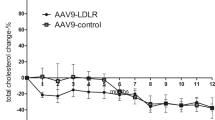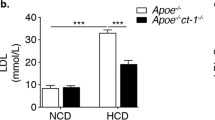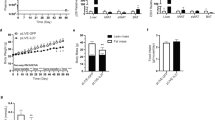Abstract
We report on systemic delivery and long-term biological effects of apolipoprotein E (apoE) obtained by intramuscular (i.m.) plasmid DNA injection. ApoE plays an important role in lipoprotein catabolism and apoE knock-out mice develop severe hypercholesterolemia and diffuse atherosclerosis. We have injected apoE-deficient mice with 80 μg of a plasmid vector (pCMV-E3) encoding the human apoE3 cDNA under the control of the CMV promoter-enhancer in both posterior legs. Local expression of the transgene was demonstrated throughout 16 weeks. Human apoE3 recombinant protein reached 0.6 ng/ml serum level. After i.m. injection of pCMV-E3 expression vector the mean serum cholesterol concentrations decreased from 439 ± 57 mg/dl to 253 ± 99 mg/dl (P < 0.05) 2 weeks after injection and persisted at a significantly reduced level throughout the 16 weeks observation period (P < 0.005). Serum cholesterol was unaffected and reached an absolute level of 636 ± 67 mg/dl in control groups. Finally, injection of pCMV-E3 into apoE-deficient mice resulted in a redistribution of cholesterol content between lipoprotein fractions, with a marked decrease in VLDL, IDL and LDL cholesterol content and an increase in HDL cholesterol. These results demonstrate that severe hypercholesterolemia in apoE-deficient mice can be effectively reversed by i.m. DNA injection, and indicate that this approach could represent a useful tool to correct several hyperlipidemic conditions resulting in atherosclerosis.
This is a preview of subscription content, access via your institution
Access options
Subscribe to this journal
Receive 12 print issues and online access
$259.00 per year
only $21.58 per issue
Buy this article
- Purchase on Springer Link
- Instant access to full article PDF
Prices may be subject to local taxes which are calculated during checkout




Similar content being viewed by others
References
Mahley RW . Apolipoprotein E: cholesterol transport protein with expanding role in cell biology Science 1988 240: 622–630
Willnow TE, Sheng Z, Ishibashi S, Herz J . Inhibition of hepatic chylomicron remnant uptake by gene transfer of a receptor antagonist Science 1994 264: 1471–1474
Mahley RW et al. Intravenous infusion of apolipoprotein E accelerates clearance of plasma lipoproteins in rabbits J Clin Invest 1989 83: 2125–2130
Yamada N et al. Apolipoprotein E prevents the progression of atherosclerosis in Watanabe heritable hyperlipidemic rabbits J Clin Invest 1992 89: 706–711
Shimano H et al. Overexpression of apolipoprotein E in transgenic mice: marked reduction in plasma lipoproteins except high density lipoprotein and resistance against diet-induced hypercholesterolemia Proc Natl Acad Sci USA 1992 89: 1750–1754
Shimano H et al. Plasma lipoprotein metabolism in transgenic mice overexpressing apolipoprotein E. Accelerated clearance of lipoproteins containing apolipoprotein B J Clin Invest 1992 90: 2084–2091
Linton MF, Atkinson JB, Fazio S . Prevention of atherosclerosis in apolipoprotein E-deficient mice by bone marrow transplantation Science 1995 267: 1034–1037
Stevenson SC et al. Phenotypic correction of hypercholesterolemia in apoE-deficient mice by adenovirus-mediated in vivo gene transfer Arterioscler Thromb Vasc Biol 1995 15: 479–484
Kashyap VS et al. Apolipoprotein E deficiency in mice: gene replacement and prevention of atherosclerosis using adenovirus vectors J Clin Invest 1995 96: 1612–1620
Cioffi L et al. A novel endothelial cell-based gene therapy platform for the in vivo delivery of apolipoprotein E Gene Therapy 1999 6: 1153–1159
Fazio VM et al. Accumulation of human apolipoprotein-E in rat plasma after in vivo intramuscular injection of naked DNA Biochem Biophys Res Commun 1994 200: 298–305
Wolff JA et al. Direct gene transfer into mouse muscle in vivo Science 1990 247: 1465–1468
Yang Y et al. Cellular immunity to viral antigens limits E1-deleted adenoviruses for gene therapy Proc Natl Acad Sci USA 1994 91: 4407–4411
Dai Y et al. Cellular and humoral immune responses to adenoviral vectors containing factor IX gene: tolerization of factor IX and vector antigens allows for long-term expression Proc Natl Acad Sci USA 1995 92: 1401–1405
Fazio VM . ‘Naked’ DNA transfer technology for genetic vaccination against infectious disease Res Virol 1997 148: 101–108
Tripathy SK et al. Long-term expression of erythropoietin in the systemic circulation of mice after intramuscular injection of a plasmid DNA vector Proc Natl Acad Sci USA 1996 93: 10876–10880
Miller G et al. Expression of factor VII by muscle cells in vitro and in vivo following direct gene transfer: modelling gene therapy for haemophilia Gene Therapy 1995 2: 736–742
Ma JX, Yang Z, Chao J, Chao L . Intramuscular delivery of rat kallikrein-binding protein gene reverses hypotension in transgenic mice expressing human tissue kallikrein J Biol Chem 1995 270: 451–455
Tsurumi Y et al. Direct intramuscular gene transfer of naked DNA encoding vascular endothelial growth factor augments collateral development and tissue perfusion Circulation 1996 94: 3281–3290
Nitta Y et al. Systemic delivery of interleukin 10 by intramuscular injection of expression plasmid DNA prevents autoimmune diabetes in nonobese diabetic mice Hum Gene Ther 1998 9: 1701–1707
Prud'homme GJ, Chang Y . Prevention of autoimmune diabetes by intramuscular gene therapy with a nonviral vector encoding an interferon-gamma receptor/IgG1 fusion protein Gene Therapy 1999 6: 771–777
Papa S et al. Development of a multigenic plasmid vector for HCV DNA immunization Res Virol 1998 149: 315–319
Zhang SH, Reddick RL, Piedrahita JA, Maeda N . Spontaneous hypercholesterolemia and arterial lesions in mice lacking apolipoprotein E Science 1992 258: 468–471
Plump AS et al. Severe hypercholesterolemia and atherosclerosis in apolipoprotein E-deficient mice created by homologous recombination in ES cells Cell 1992 71: 343–353
Jiao S et al. Direct gene transfer into nonhuman primate myofibers in vivo Hum Gene Ther 1992 3: 21–33
Sullivan PM et al. Targeted replacement of the mouse apolipoproteine E gene with the common human APOE3 allele enhances diet-induced hypercholesterolemia and atherosclerosis J Biol Chem 1997 272: 17972–17980
Boisvert WA, Spangenberg J, Curtiss LK . Treatment of severe hypercholesterolemia in apolipoprotein E-deficient mice by bone marrow transplantation J Clin Invest 1995 96: 1118–1124
Chapman BS, Thayer RM, Vincent KA, Haigwood NL . Effect of intron A from human cytomegalovirus (Towne) immediate–early gene on heterologous expression in mammalian cells Nucleic Acids Res 1991 19: 3979–3986
Mahley RW, Innerarity L, Rall SC, Weisgraber KH . Plasma lipoproteins: apolipoprotein structure and function J Lipid Res 1984 25: 1277–1294
Mahley RW et al. Cellular and molecular biology of lipoprotein metabolism: characterization of lipoprotein receptor–ligand interactions Cold Spring Harbor Symp Quant Biol 1986 51: 821–828
Van Eck M et al. Bone marrow transplantation in apolipoprotein E-deficient mice Arterioscler Thromb Vasc Biol 1997 17: 3117–3126
Bellosta L et al. Macrophage-specific expression of human apolipoprotein E reduces atherosclerosis in hypercholesterolemic apolipoprotein E-null mice J Clin Invest 1995 96: 2170–2179
Fenjves ES, Smith J, Zaradic S, Taichman LB . Systemic delivery of secreted protein by grafts of epidermal keratinocytes: prospects for keratinocyte gene therapy Hum Gene Ther 1994 5: 1241–1248
Wolff JA et al. Conditions affecting direct gene transfer into rodent muscle in vivo Biotechniques 1991 11: 474–485
Harvey BG et al. Cellular immune responses of healthy individuals to intradermal administration of an E1−E3− adenovirus gene transfer vector Hum Gene Ther 1999 10: 2823–2837
Roe T, Renolds TC, Yu G, Brown PO . Integration of murine leukemia virus DNA depends on mitosis EMBO J 1993 12: 2099–2108
Yao SN, Kurachi K . Expression of human factor IX in mice after injection of genetically modified myoblasts Proc Natl Acad Sci USA 1992 89: 3357–3361
Davis HL et al. Plasmid DNA is superior to viral vectors for direct gene transfer into adult mouse skeletal muscle Hum Gene Ther 1993 4: 733–740
Dhawan J et al. Systemic delivery of human growth hormone by injection of genetically engineered myoblasts Science 1991 254: 1509–1512
Wolff JA et al. Long-term persistence of plasmid DNA and foreign gene expression in the mouse muscle Hum Mol Genet 1992 1: 363–369
Wu CH, Wilson JM, Wu GY . Targeting genes: delivery and persistent expression of a foreign gene driven by mammalian regulatory elements in vivo J Biol Chem 1989 264: 16985–16987
Friedmann T et al. Retrovirus vector-mediated gene transfer into hepatocytes Mol Biol Med 1989 6: 117–125
Martin T et al. Plasmid DNA malaria vaccine: the potential for genomic integration after intramuscular injection Hum Gene Ther 1999 10: 759–768
Ciafrè SA et al. Stability and functional effectiveness of phosphorothioate modified duplex DNA and synthetic ‘mini-genes’ Nucleic Acid Res 1995 23: 4134–4142
Goldstein JL, Brown MS . The Metabolic Basis of Inherited Disease McGraw-Hill: New York 1983 pp 672–712
Piedrahita JA et al. Generation of mice carrying a mutant apolipoprotein E gene inactivated by gene targeting in embryonic stem cells Proc Natl Acad Sci USA 1992 89: 4471–4475
Chomczynski P, Sacchi N . Single-step method of RNA isolation by acid guanidinium thiocynate-phenol-chloroform exctraction Anal Biochem 1987 162: 156–159
Havel RJ, Eder HA, Bragdon JH . The distribution and chemical composition of ultracentrifugally separated lipoproteins in human serum J Clin Invest 1955 34: 1345–1353
Lowry OH et al. Protein measurement with folin phenol reagent J Biol Chem 1951 193: 265–275
Acknowledgements
This research was partially supported by Italian Ministero della Sanità, RC-IRCCS and MURST 60% to VMF. We thank the staff of ‘Servizio Stabulario’, Catholic University of Rome, for expert and excellent technical assistance with animals.
Author information
Authors and Affiliations
Rights and permissions
About this article
Cite this article
Rinaldi, M., Catapano, A., Parrella, P. et al. Treatment of severe hypercholesterolemia in apolipoprotein E-deficient mice by intramuscular injection of plasmid DNA. Gene Ther 7, 1795–1801 (2000). https://doi.org/10.1038/sj.gt.3301310
Received:
Accepted:
Published:
Issue Date:
DOI: https://doi.org/10.1038/sj.gt.3301310
Keywords
This article is cited by
-
Synthetic lipoproteins based on apolipoprotein E coupled to fullerenol have anti-atherosclerotic properties
Pharmacological Reports (2022)
-
Pharmaceutical induction of ApoE secretion by multipotent mesenchymal stromal cells (MSCs)
BMC Biotechnology (2008)
-
Immune response at birth, long-term immune memory and 2 years follow-up after in-utero anti-HBV DNA immunization
Gene Therapy (2004)
-
Inhibition of atherosclerosis in apolipoprotein-E-deficient mice following muscle transduction with adeno-associated virus vectors encoding human apolipoprotein-E
Gene Therapy (2002)



